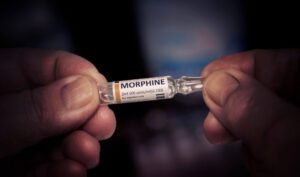Addiction represents a complex and chronic condition where individuals compulsively seek and engage in the use of substances or behaviors, despite awareness of potential harmful consequences. It fundamentally alters the brain’s system associated with reward, motivation, and memory, creating an intense craving for a substance or activity. The development of addiction transcends the initial voluntary action, evolving into a need that can dominate an individual’s life, often leading to detrimental effects on health, relationships, and societal obligations.

Substance addiction involves chemical substances such as alcohol, nicotine, or drugs, whereas behavioral addiction refers to a compulsion to engage in activities like gambling, eating, or working. Both forms of addiction share similar neurological pathways, characterized by a reinforced cycle of cravings and reward. The condition is influenced by various factors including genetics, environmental triggers, psychological state, and life experiences. Addiction treatment is multifaceted, typically necessitating a comprehensive approach that may include therapy, medication, and support groups, aimed at helping individuals regain control over their lives.
Understanding Drug Addiction and Substance Use Disorder

Addiction is a complex condition characterized by compulsive behaviors and substance use despite harmful consequences. This section delves into its definition and the various forms it can take.
Definition of Addiction
Addiction is recognized as a chronic dysfunction of the brain’s reward, motivation, and memory systems. The condition leads individuals to compulsively seek and consume substances like alcohol or engage in behaviors such as gambling, often to the detriment of their health and wellbeing. This compulsive action persists even when negative consequences are evident.
Types of Addiction
-
Substance-Related Addictions:
-
Behavioral Addictions:
- Gambling, Gaming, and Internet: These activities become addictions once they interfere with daily life and responsibilities.
- Food-Related: An individual may become addicted to eating, involving compulsive consumption patterns.
- Shopping and Sex: These behaviors may initially bring pleasure or serve as a coping mechanism but can escalate to addiction.
The recurrent nature of addiction means that individuals may relapse into previous compulsive behaviors, underscoring the need for comprehensive and sustained treatment strategies.
Causes and Risk Factors
Understanding the causes and risk factors of addiction is crucial as it influences the approach to prevention and treatment. Addiction is rarely a result of a single factor; instead, it’s the interplay between genetic makeup, environmental pressures, and psychological elements.

Genetic Influence
Genetic factors account for approximately 40-60% of an individual’s risk for addiction. The presence of certain genes can make one more susceptible to substance abuse and addiction. Studies suggest that genetic predispositions can influence the way an individual’s brain reacts to addictive substances, potentially accelerating the development of addiction.
Environmental Factors
Environmental influences play a significant role in the emergence of addictive behaviors. Elements such as a person’s family life, relationships, exposure to physical or emotional abuse, peer pressure, and socioeconomic status can all raise the likelihood of addiction. Additionally, easy accessibility to substances acts as a significant risk factor in the development of addiction behaviors.
Psychological Contributors
Individuals with certain mental disorders may have an elevated risk of developing addiction, as they might turn to substances as a form of self-medication. Stress is another psychological contributor that can trigger substance use as a coping mechanism. Moreover, the display of risk-taking behavior, lack of impulse control, and the presence of other behavioral disorders are influential risk factors in the propensity towards addictive behavior.
The Neuroscience of Addiction
Addiction involves complex interactions within the brain that influence reward, memory, and self-control. These changes ultimately disrupt various neural circuits, including those in the prefrontal cortex, a critical region for decision-making.
Brain Reward System
The brain reward system is central to understanding addiction. This system is primarily governed by the neurotransmitter dopamine, which plays a significant role in reward, pleasure, and reinforcement. Activation of this system reinforces behaviors by producing feelings of enjoyment, ensuring individuals repeat the actions necessary to achieve similar effects.
- Reward and Relapse: Exposure to addictive substances or behaviors increases dopamine release, strengthening neural pathways and potentially leading to compulsive repetition and, eventually, addiction. When dopamine levels decrease, individuals may experience withdrawal and cravings, increasing the risk of relapse.
Changes in Brain Function
Addiction leads to several fundamental changes in brain function. Continued substance use or engagement in addictive behaviors can result in:
- Adaptations in neuronal connectivity, making the brain less responsive to the substance or behavior and more sensitive to stress-related cues.
- Impairment in regions that underlie self-control, such as the prefrontal cortex, which can lead to decision-making that favors immediate rewards over long-term well-being.
- Brain Changes: Repeated exposure to addictive stimuli can lead to enduring brain changes, which may persist even after substantial periods of abstinence.
Role of Neurotransmitters
Neurotransmitters, particularly dopamine, are pivotal in the addiction process. Other neurotransmitters like serotonin and glutamate are also involved.
- Dopamine: Central to the reward pathway, it reinforces behaviors by signaling pleasure and reward.
- Serotonin: It influences mood, which can be a contributing factor in the persistence of addictive behaviors.
- Glutamate: It’s involved in learning and memory, which affects the contextual association with substance use and can contribute to the difficulty of overcoming addiction.
Diagnosis and Symptoms

The diagnosis of addiction hinges on the identification of specific symptoms which align with established criteria. Recognition of these symptoms is crucial as it guides healthcare providers to an appropriate diagnosis and informs the subsequent treatment plan.
Diagnostic Criteria
According to the American Psychiatric Association, the Diagnostic and Statistical Manual of Mental Disorders, Fifth Edition (DSM-5) outlines clear diagnostic criteria for substance use disorders. The criteria encompass a range of behavioral and physiological factors, including tolerance, where an individual needs significantly increased amounts of a substance to achieve the desired effect, and withdrawal symptoms, which manifest when substance use is reduced or ceased.
- Tolerance: A need for markedly increased amounts to achieve intoxication or desired effect or markedly diminished effect with continued use of the same amount.
- Withdrawal: The characteristic withdrawal syndrome for the substance or the same (or closely related) substances are taken to relieve or avoid withdrawal symptoms.
The presence of at least two of these symptoms within a 12-month period may indicate an addiction diagnosis.
Recognizing Addiction
Recognizing addiction involves observing specific signs in behavior and physical health. Individuals may exhibit a persistent desire or unsuccessful efforts to cut down or control substance use, known as craving, a powerful desire or urge to use a specific substance. Additionally, a significant amount of time may be spent in activities necessary to obtain the substance, use the substance, or recover from its effects.
Significant symptoms indicating addiction:
- Craving: An intense desire or urge for the drug that can occur at any time but particularly when in an environment where the drug was previously obtained or used.
- Lifestyle impact: Continued substance use despite having persistent or recurrent social or interpersonal problems caused or exacerbated by the effects of the substance.
Understanding these symptoms is vital for the early detection of addiction, which can lead to more effective treatment and better outcomes for individuals. Identifying withdrawal and recognizing the signs of tolerance are particularly important in this regard.
Consequences of Addiction

Addiction, whether it involves substances like opioids, cocaine, or nicotine, or behaviors, leads to severe disruptions in one’s life. It manifests as a chronic disease that creates a compulsive need to seek and use a substance or activity, leading to harmful consequences to both health and societal aspects.
Health Implications
Acute Health Risks:
- Overdose: Substances like opioids can cause an overdose, potentially resulting in coma or death.
- Mental Health: Chronic misuse can impair mental health, driving issues such as anxiety, depression, and anger.
Long-term Health Risks:
- Detoxification: The process to remove a substance from the body can be dangerous if not medically supervised.
- Addiction-related Diseases: Regular abuse can lead to diseases such as cardiovascular disorders, liver damage, or respiratory problems.
Behavioral Changes:
- Substances like THC can alter perceptions, resulting in pleasure but also impairment in judgment and coordination.
- Addiction often brings feelings of shame, affecting an individual’s overall mental health and well-being.
Social and Economic Effects
Family and Relationships:
- Dysfunction: Addictive behaviors often harm relationships, leading to social isolation and conflicts within families.
- Child Neglect: Substance misuse can result in inadequate care of dependents, causing long-term psychological effects on children.
Economic Impact:
- Productivity Loss: Individuals may experience decreased productivity at work or school, resulting in job loss or educational failure.
- Healthcare Costs: The need for medical treatment, rehabilitation, and emergency responses places a strain on healthcare resources.
Criminal Justice System:
- Substance abuse can lead to illegal activities, putting a burden on the legal system and resulting in incarceration and rehabilitation costs.
Substance abuse and addiction are not just personal struggles; they resonate through health, relationships, and economic stability, affecting society as a whole.
Treatment and Recovery

Addiction is a complex but treatable disorder that can be addressed with a range of effective treatments and recovery processes. The journey to recovery typically involves medical interventions, behavioral therapies, and ongoing support and rehabilitation, each tailored to individual needs.
Medical Interventions
Medications play a crucial role in treating substance use disorders, especially those related to opioids. For opioid addiction, medications like methadone, buprenorphine, and naltrexone can help to reduce cravings and manage withdrawal symptoms, improving the chances of a successful recovery. In cases of overdose, drugs like naloxone can reverse the effects of opioids, specifically life-threatening substances such as fentanyl.
Behavioral Therapies
Behavioral therapies are essential in treating drug addiction. Cognitive-behavioral therapy (CBT) aids in modifying the patient’s drug use expectations and behaviors, and in effectively managing triggers and stress. Therapies such as motivational interviewing and incentive-based motivation enhancement therapy can enhance individuals’ readiness to change their addictive behaviors and adhere to other aspects of treatment, like medication.
Support and Rehabilitation
Long-term recovery is supported by comprehensive rehabilitation programs that include a combination of therapy and community support. Psychotherapy plays a significant role in addressing the root psychological triggers for addiction. Additionally, peer support groups such as those offered by 12-step programs encourage sustained recovery by providing a supportive network and a framework for substance-free living. It’s critical to note that relapse can be a part of the journey, and these programs help to strengthen relapse prevention strategies.
Prevention and Education

Effective prevention and education strategies are critical in mitigating the risk of addiction and fostering resilience within individuals and communities. These efforts target various factors including stress, anxiety, depression, and other mental health issues that can lead to substance misuse.
Community Outreach
Community outreach programs play a pivotal role in prevention by addressing the roots of addiction, such as mental health struggles and social factors. They offer resources to reduce stress and anxiety, which are often precursors to substance use. Outreach initiatives also work to build strong, supportive relationships and networks to buffer against the isolating effects of depression.
Early Intervention
Early intervention is key to preventing the escalation of substance experimentation to full-blown addiction. It often takes place in schools where educators and counselors can identify at-risk behaviors early. Screening for mental health issues and implementing strategies for managing stress and anxiety are crucial steps that can deter the path to addiction.
Educational Programs
Educational programs within schools and communities impart knowledge about the dangers of substance misuse. They seek to curb experimentation by illustrating the potential impacts on health, relationships, and life prospects. Equipped with facts, individuals are more likely to make informed decisions and resist peer pressure that can lead to substance abuse.
Preventive education also reinforces healthy coping mechanisms for dealing with stress, anxiety, and depression, empowering individuals to seek constructive solutions rather than turning to substance use.
Emerging Trends and Research

The field of addiction science is continually evolving, with new substances and behaviors frequently emerging alongside advancements in treatment. This leads to a deeper understanding of addiction and enhances our ability to combat addictive disorders.
New Substances and Behaviors
Researchers are identifying novel psychoactive substances (NPS) and behaviors that can lead to addiction. These include synthetic hallucinogens and the abuse of prescription medications, which may affect the brain’s reward system and lead to substance addiction. Additionally, behavioral addictions like gambling disorder, video gaming, and internet gaming disorder are receiving increased attention. With new trends in drug use and addictive behaviors, there is a heightened risk of drug seeking, irritability, and withdrawal symptoms indicative of abstinence. Studies highlight the rise in risky behaviors, particularly during times of societal stress, such as the observed spike in alcohol use disorder during the pandemic.
Advancements in Treatment
In the realm of treating addiction, the focus has broadened from solely addressing alcohol use disorder to incorporating a multi-substance approach given the diverse nature of addictive substances. There has been progress in developing personalized interventions targeting the specific challenges and needs of individuals with an addictive disorder. For example, treatments now consider the impact of addiction on neural circuits and how to modulate them to reduce addictive behaviors. Current research on substance use disorders and addiction provides insights into the underlying mechanisms of addiction and how they can be managed clinically.
Conclusion:
Understanding addiction is imperative in addressing the complexities of compulsive behaviors and substance use disorders. It transcends mere behavior and delves into the intricate interplay of genetic predispositions, environmental influences, and neurological alterations. Addiction’s pervasive impact not only affects individuals but also reverberates through communities, straining relationships, compromising health, and burdening societal structures.
The journey to recovery demands a multifaceted approach, encompassing medical interventions, behavioral therapies, and robust support systems. It necessitates a shift from stigmatization to empathy, recognizing addiction as a chronic illness rather than a moral failing. Through prevention efforts, early intervention, and ongoing education, we can mitigate the risk of addiction and foster resilience within individuals and communities.
As research continues to unravel the complexities of addiction, emerging trends and advancements in treatment offer hope for more effective interventions and improved outcomes. By embracing a holistic understanding of addiction and addressing its underlying causes, we can work towards a future where individuals are empowered to break free from the chains of addiction and reclaim their lives. Together, through compassion, collaboration, and commitment, we can build a society where recovery is not only attainable but celebrated.






